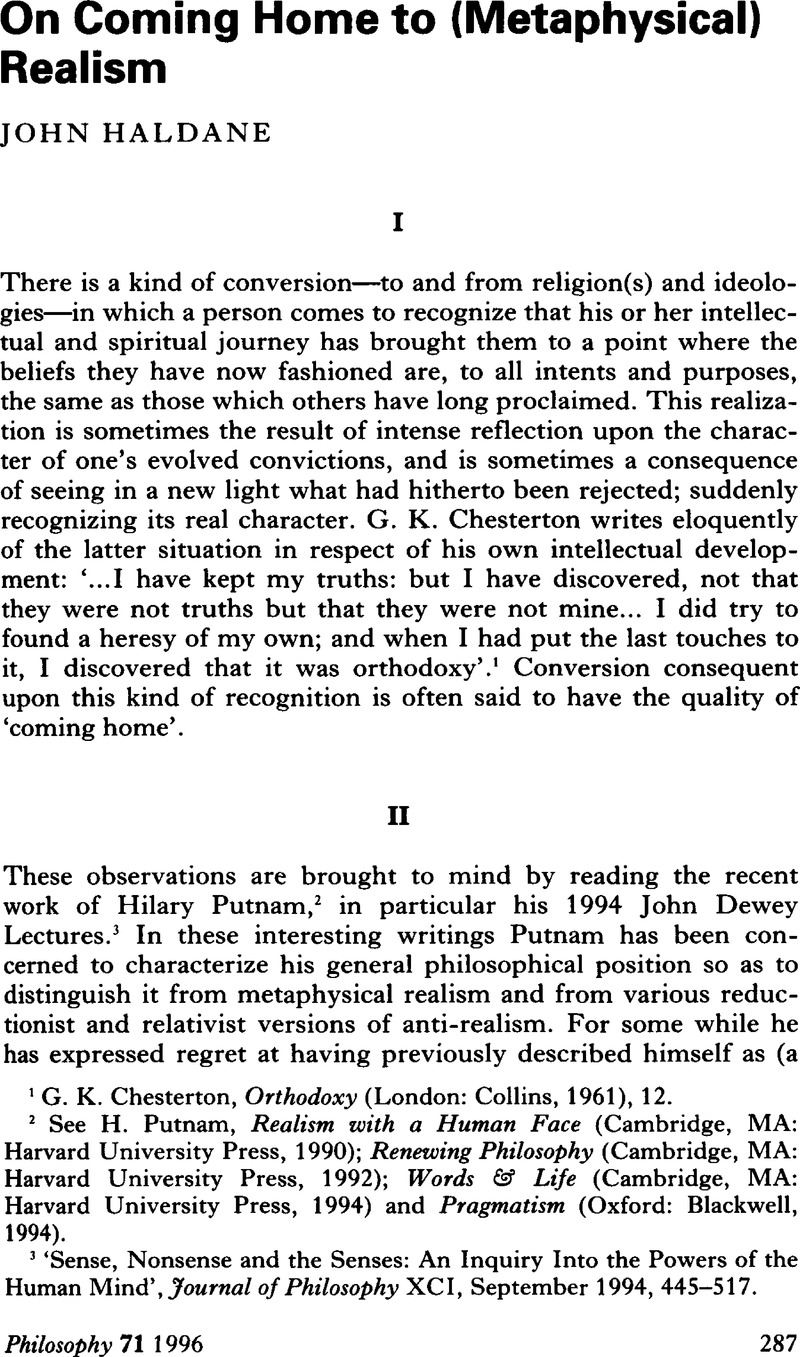Published online by Cambridge University Press: 30 January 2009

1 Chesterton, G. K., Orthodoxy (London: Collins, 1961), 12.Google Scholar
2 See Putnam, H., Realism with a Human Face (Cambridge, MA:Harvard University Press, 1990)Google Scholar; Renewing Philosophy (Cambridge, MA:Harvard University Press, 1992); Words & Life (Cambridge, MA:Harvard University Press, 1994) and Pragmatism (Oxford: Blackwell, 1994)
3 ‘Sense, Nonsense and the Senses: An Inquiry Into the Powers of the Human Mind’, Journal of Philosophy XCI, September 1994, 445–517.
4 See Reason, Truth and History (Cambridge University Press, 1981).
5 ‘Sense, Nonsense and the Senses’, 447 & 465.
6 ‘Sense, Nonsense and the Senses’, 461; this being a gloss of the view presented in the preface to Realism with a Human Face.
7 ‘Sense, Nonsense and the Senses’, 502–517.
8 Reprinted in Meaning and the Moral Sciences (London: Routledge & Kegan Paul, 1978), 123–140.
9 See: Haldane, J., ‘Brentano's Problem’, Grazer Philosophische Studien, 35, 1989, 1–32CrossRefGoogle Scholar; ‘Reid, Scholasticism and Current Philosophy of Mind’, in Dalgarno, M. & Matthews, E. (eds) The Philosophy of Thomas Reid (Dordrecht: Reidel, 1989), 285–304CrossRefGoogle Scholar; ‘Putnam of Intentionality’,Philosophy and Phenomenological Research, 1991, 671–682; ‘Mind-World Identity Theory and the Anti-Realist Challenge’ in Haldane, J & Wright, C. (eds) Reality, Representation and Projection (New York: OUP, 1993), 15–37Google Scholar; ‘Whose Theory? Which Representations?’, Pacific Philosophical Quarterly, 74, 1993, 247–257; and ‘The Forms of Thought’in Hahn, L., (ed.) The Philosophy of Roderick Chisholm, Library of Living Philosophers (La Salle, Illinois: Open Court, forthcoming).Google Scholar
10 See ‘Aristotle after Wittgenstein’ in Sharpies, R. W. (ed.) Modern Thinkers and Ancient Thinkers (London: UCL Press, 1993), 117–137;reprinted in Words & Life.Google Scholar
11 Haldane, J., ‘Humanism with a Realist Face’, PhilosophicalBooks, 35, 1994, 21–29.Google Scholar
12 Summa Theologiae, IIa, IIae, q.8, a. 1, responsio. Adapted from the literal translation by Fathers of the English Dominican Province (London: R. & T. Washbourne, Ltd., 1916), 95.
13 Summa Theologiae, Ia, q. 85, a. 2. Adapted from the literal translation by Fathers of the English Dominican Province (London: R. & T.Washbourne, Ltd., 1912), 184.
14 On which see McDowell, John, Mind and World (Cambridge, MA: Harvard University Press, 1994)— work that has had a marked, and acknowledged, influence on Putnam's recent thinking.Google Scholar
15 Chesterton, G. K., St Thomas Aquinas, (London: Hodder & Stoughton, 1933), 171–172.Google Scholar
16 See, for example, ‘Sense, Nonsense and the Senses’, 447, fn.4
17 ‘Sense, Nonsense and the Senses’, 450–451.
18 See, for example, Quaestiones Disputatae de Veritate, q. 1, a. 1.
19 Though ultimately I do not believe that one can, and hence hold that all substances are artefacts—God is not a substance. See ‘Theism’ in Smart, J. J. C. and Haldane, J., Atheism and Theism (Oxford: Blackwell, 1996).Google Scholar
20 See, for example, Summa Theologiae, Ia, q. 13, 1–6. For an account of the idea see Mclnerny, Ralph, The Logic of Analogy (The Hague:Nijhoff, 1961) and more recently ‘Aquinas and Analogy: Where Cajetan Went Wrong’, Philosophical Topics, 20, 1992, 103–124.Google Scholar
21 See Kenny, A., ‘Aquinas and Wittgenstein’, Downside Review, Vol. 77, 1959,CrossRefGoogle Scholar and Chapman, T., ‘Analogy’, The Thomist, Vol. 39, 1975.CrossRefGoogle Scholar
22 For further elaboration and defence of this idea see my ‘Mind-World Identity Theory and the Anti-Realist Challenge’ and ‘The Forms of Thought’.